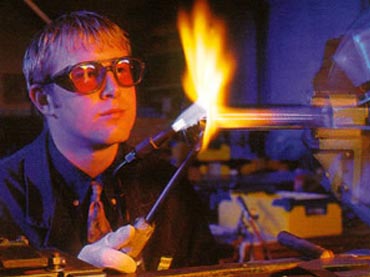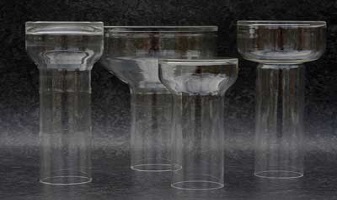Glass is everywhere around us.
In our homes.
In our cars.
Even right in front of our eyes for some people.
When you see a substance such as glass every day, it can be easy to forget the complex method of creating it that takes place.
At Moore’s Glassworks, we have manufactured glass for decades, and that’s why we’ve written this quick guide the process of creating glass, and the different types of glass that can be made.
Let’s take a look.
What is Glass Made From?
For centuries, glass has been created from the same elements.
One of the main ingredients of glass is sand. When extreme heat is applied to sand, it’s internal structure changes drastically, and what can be left is a glass-like substance.
A great example of this (albeit rather a strange one) is when a prototype of the atomic bomb was exploded in New Mexico Desert in 1945. This led to the sand that was at the heart of the explosion being subjected to high levels of heat and left it resembling glass.
While this is an extreme example, it showcases how sand is transformed into glass.
In more modern times, glass is produced on mass scale in dedicated plants.
The most common form of glass created in these manufacturing plants is known as soda-lime glass.
This is because of it’s three ingredients, which are soda (also known as soda ash), limestone, and sand.
This concoction is melted together to form a liquid substance, that when cooled will turn into a solid.
A Step-by-Step Guide
This can sound simple, but it is actually a complex process.
Here is a quick guide on just what happens as the glass is formed:
- All of the ingredients are mixed together to form what will become the glass. This is currently in a cool climate and the substances will be in their solid form.
- The next step is optional and depends on the desired product. If you’re looking for stained glass, or glass that may be used for reading glasses for example, you may have to add further chemicals here to get the desired effect on the finished product.
- The mixture is placed in a container that is able to withstand extreme heat. From here, heat is applied while the substance is mixed until it becomes a liquid.
- Once the glass is hot enough, parts of it can safely be removed and shaped. If you’re creating windows, they will be placed into moulds. If you’re creating more bespoke products, such as items manufactured at Moore’s Glassworks like vacuum viewports and cathode ray tubes, then you will often form the shapes by hand, or using an auto lathe.
- The final process is when the molten glass is placed in a container or kiln to cool down. This is known as annealing, and you must be very careful to avoid stress damage as the substance becomes solid.
- Once the glass is solid and in shape, any extra coating can be added, and the product is complete. This is also the right time to perform quality control checks, to make sure the product is fit for purpose and safe to use.

Different Types of Glass
There are many different types of glass that are commonly created and used throughout society, and here are three of the most used varieties.
Toughened Glass (a.k.a Safety Glass)
Sometimes glass is required to be able to withstand heavy stress and heat.
In this case, you may need toughened glass, also known as tempered.
This is commonly used on windows, doors, and mobile phone screen protectors.
When the glass is in the manufacturing process, the final stage is a bit different when creating this type of glass. When the glass is being heated up, it goes to a higher temperature than normal. The substance then goes through a rapid cooling process, which solidifies the outer layers quickly.
This extra heat stress makes the glass tougher and able to withstand much more stress when being used.
Toughened glass doesn’t smash as easily and into as sharp fragments as ordinary glass, and therefore makes it a great choice for use on car windows and other products where safety is paramount.
Heat-Strengthened Glass
This is similar to tempered glass, but the cooling process is much slower.
While this doesn’t make the glass quite as tough as toughened glass, it does have some advantages.
The different methods of cooling mean that heat-strengthened glass breaks differently. Whereas tempered may not split into shards that are sharp, heat-strengthened will, which is why tempered is a better choice for safety.
Heat-strengthened glass is better visually than toughened glass and is often much clearer which makes it a good choice for some windows.
If safety glass isn’t needed, then toughened glass may be seen as overkill, and in that case, heat-strengthened glass is a great alternative.
Annealed Glass
Annealed glass is what can be best described as ‘normal’.
This is glass that hasn’t gone through any thermal stress greater than it needs, and has also been cooled at a normal rate.
Toughened glass is around four times stronger than annealed, and heat-strengthened is around two times stronger, so it is by no means the toughest thing on the market, but it is perfectly suitable to do a job when safety glass, or extra strong glass isn’t needed.
Something such as the window in a cabinet is a good situation where the other types of glass would be excessive and annealed glass would be just right.
Moore’s Glassworks: Custom Glass Manufacturers
So, why am I talking about creating glass?
Well, here at Moore’s Glassworks we manufacture many different glass products, from glass condom moulds to multi-pin stems.
To form these products, we use experienced hand-blowers and our auto-lathe machines to take the molten glass and formulate it into the exact shape required.
To know how glass works, and when we need to create different types of glass, such as tempered and heat-strengthened, we must know the ins and outs of the exact substance we’re dealing with.
For centuries glass has been made from heating sand, and it will for centuries more.
If you’re looking for custom glass manufacturers based in the UK, get in touch with Moore’s Glassworks today.
We offer a bespoke service and can create your desired product to the exact dimensions.
We look forward to hearing from you.


Leave a Reply